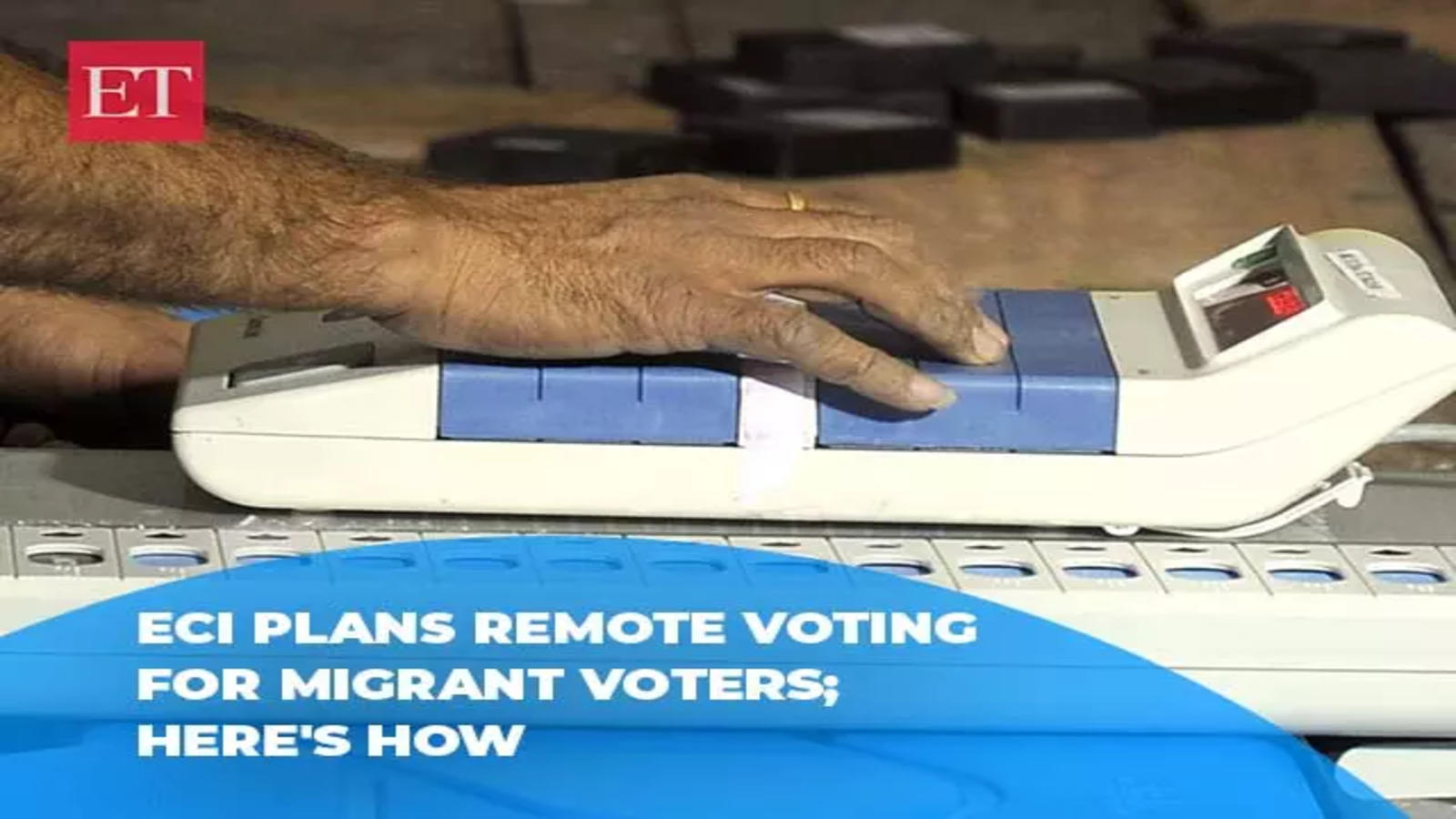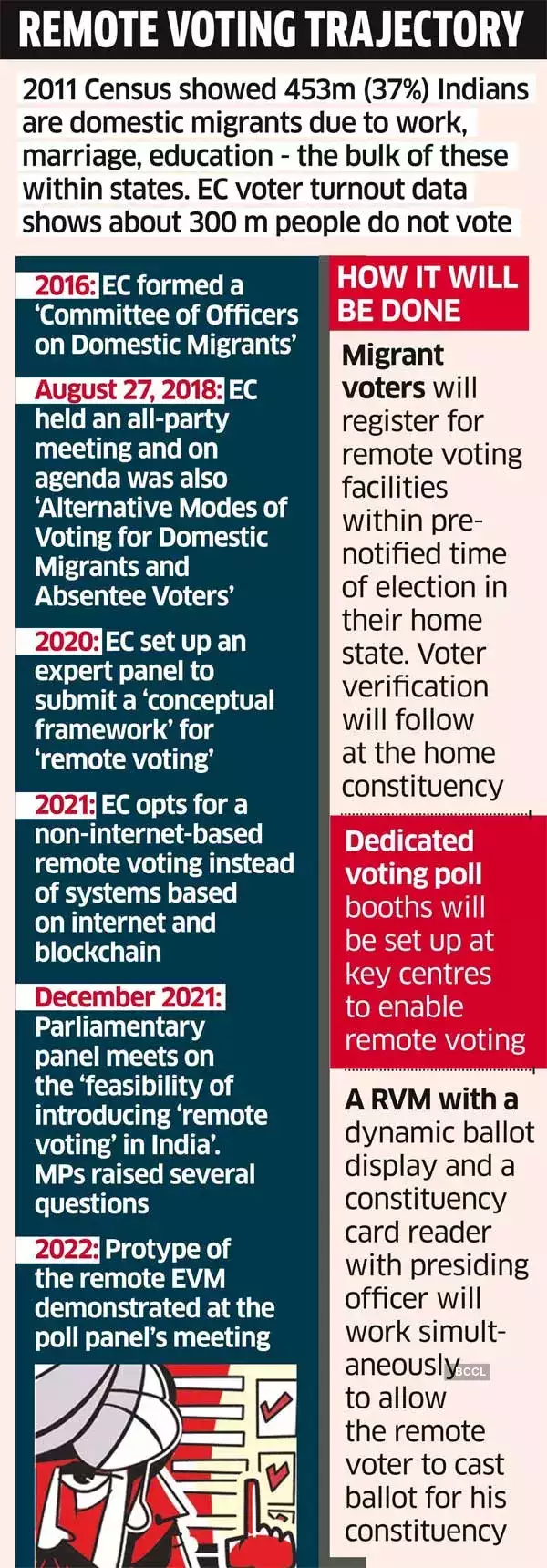Description

Copyright infringement not intended
In News
- The Election Commission of India (ECI) announced a pilot project to conduct remote voting for domestic migrants so that they can vote without travelling back to their home states.
- The main objective is to increase voter turnout and strengthen India’s democratic system.
- The commission has developed a prototype for a Multi-Constituency Remote Electronic Voting Machine (RVM) that can handle multiple constituencies voting from a single remote polling booth.
- It has invited all recognized eight national and 57 state political parties to display the functioning of the RVM on 16th January 2023.
.jpg)
Details
- Domestic migration is one of the major reasons why registered voters do not vote in the election.
- According to the Election Commission, there is a large group of the population which is denied its franchise due to the necessity of work or lack of resources to travel. This goes directly against the EC’s objective of “No voter left behind”.
- According to the 2011 census, there are more than 45 crore migrants in India (both intra and interstate), which is approximately 37% of the country’s population.
- Migration can be driven by various Push factors and Pull Factors
- Push factors in migration include limited job opportunities, political oppression, conflict, natural disasters, and corruption. Push factors of migration are economic, political, cultural, or a combination.
- Pull Factors are factors which attract migrants to an area. Opportunities for better employment, higher wages, facilities, better working conditions and attractive amenities are pull factors of an area.
Remote Electronic Voting Machine (RVM)
- In 2016, the Election Commission formed a “Committee of Officers on Domestic Migrants”, which submitted various possible solutions such as internet voting, proxy voting, early voting and postal ballots for migrant workers.
- However, most of these ideas were rejected due to reasons such as the lack of secrecy of the vote, the lack of sanctity of one person one vote principle, issues of accessibility for unlettered voters, etc.
- The committee also proposed a technological solution which depends on the creation of a robust electoral roll and identification mechanisms (to stop duplicate voting) and allows voters to vote remotely, in a safe and secure environment.
- The Remote Electronic Voting Machine (RVM) was developed with the assistance of Bharat Electronics Limited (BEL) and the Electronics Corporation of India Limited (ECIL).
- It is based on the currently used EVM system.
- It allows voters from multiple constituencies to vote using the same machine.
- RVMs are “stand-alone, non-networked systems,” effectively providing the voter with the same experience as currently used EVMs.
- It will be set up in remote locations outside the state under identical conditions as current polling booths.
- A single Remote Ballot Unit (RBU) can cater to multiple constituencies (as many as 72) by using a “dynamic ballot display board” instead of the usual printed paper ballot sheet on EVMs.
- The Ballot Unit Overlay Display (BUOD) will display the candidates' names and symbols based on the constituency number mentioned on the voter’s identity card. A barcode scanning system will be used to read these cards.
- The voting process will be as follows:

Important Reforms Taken in Electoral System
- The right to vote irrespective of Caste, Creed, Religion or Gender.
- Lowering the voting age from 21 to 18 through the 61st Amendment Act of 1988.
- Provision was made for voting by Certain Classes of Persons through Postal ballot.
- A facility for voting through Proxy was provided to the Service voters belonging to the Armed forces.
- Rajya Sabha elections were reformed by removing the domicile of the Contesting Candidate and the Introduction of an open ballot system was introduced.
- Exemption of travelling expenditure from being included in the election expenses of the Candidate was made.
- Restrictions were imposed on conducting exit Polls and Publishing the results of exit Polls.
- Provision was made for the disqualification of a Person found guilty of Corrupt Practices.
- Appointment of appellate authorities within the district.
- Voting rights for Citizens of India living abroad were provided in 2010.
- The ceiling on election expenditure was increased.
- Those who are deemed unsound of mind and People Convicted of Certain Criminal offences are not allowed to vote.
- Introduced Electoral Photo Identity Card, which also allows certain alternative documents like government I-Cards, Passports, PAN Cards, driving licenses, bank/Post office account Passbook, Property documents, SC/ST/OBC Certificate, Pension documents, Job cards issued under NREGA and Health insurance Scheme Smart Cards to establish the identity of the electors in the Polling Stations.
- Introduced by 52nd Amendment Act, for the disqualification of the members of Parliament and the State legislatures on the ground of defection from one Political Party to another.
- Disqualification on grounds of defection is not to apply in the case of a Split.
- The model Code of Conduct evolved by the Election Commission is based on a consensus among political parties.
- All Recognized National and State Parties have been allowed free access to the State-owned electronic media: AIR and Doordarshan.
- NOTA Option - In its efforts of Cleansing the Political System, Supreme Court upheld the right of voters to reject all candidates contesting the elections.

Election Commission of India
- It is a permanent constitutional body.
- Article 324 of the constitution establishes the Election Commission of India.
- It was established on 25th January 1950.
- It supervises the conduct of elections to Parliament and Legislature of every State and elections to the offices of President and Vice-President of India.
- It consists of the Chief Election Commissioner and two Election Commissioners.
- Originally, there was only Chief Election Commissioner, there were no Election Commissioners.
- The President appoints Chief Election Commissioner and Election Commissioners.
- Tenure of 6 years, or up to the age of 65 years, whichever is earlier.
- The status, salary and perks of election commissioners are equivalent to Judges of the Supreme Court of India.
- The Chief Election Commissioner can be removed from office only through impeachment by
- Other members can be removed by the President in consultation with the Chief Election Commissioner.
- The President may appoint Regional Election Commissioners in consultation with the CEC before elections to the Parliament or Assemblies.
- The Chief Election Commissioner cannot be reappointed to the post.

Copyright infringement not intended
https://indianexpress.com/article/explained/migrant-workers-cast-vote-remotely-what-is-ecs-new-technology-8351170/













